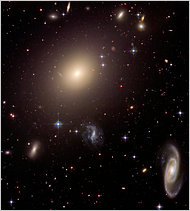
Well, the first most obvious observation is that galaxies are not the same size, some only have 10 Million stars, while other giants can have as many as 10 Trillion stars. As to the number of galaxies, 100 Billion is the low number, it may in fact be a lot higher, perhaps a trillion or more. So to translate that, any answer can only ever be a rough guess, its not a precise number.
So, now we have something new on all this. A couple of days ago (Dec 1), the New York Times ran an article about the latest insights …
Scientists said …the number of stars in the universe had been seriously undercounted, and they estimated that there could be three times as many stars out there as had been thought.
Now, I don’t know about you, but for me the term “Scientists said….” is a wee bit vague. For example, if a biologist starts spouting about cosmology then be skeptical, its not his subject matter. So am I casting doubt on the story content? Nope, its accurate, its just a minor gripe I have about the author deploying this dumbed down term “Scientists said….”. However, lets forget that and take a closer look at what has been discovered …
Pieter van Dokkum, a professor of astronomy at Yale who reported the findings in the journal Nature with Charlie Conroy of the Harvard-Smithsonian Center for Astrophysics in Cambridge, Mass.
Ah good, this is coming from Subject matter experts …
The conundrum is that astronomers cannot actually count the dwarf stars, which have masses less than a third of that of the Sun, in galaxies outside the Milky Way. So instead, they counted the brighter Sun-like stars and assumed that there were about 100 unseen dwarfs for each larger Sun-like star, as is the case in the Milky Way.
Yet not every galaxy looks like the Milky Way, with its spiraling pinwheel arms. Some are blobby and elliptical, and it was an untested assumption that the distribution of star sizes in elliptical galaxies is the same as in the Milky Way.
Dr. van Dokkum and Dr. Conroy took an innovative approach to counting what they could not see. Because the dwarfs are cooler, the fingerprint of certain colors they emit and absorb is different from that of larger stars. Thus, while they could not see individual stars, the astronomers could calculate the number of dwarfs required to produce the telltale color fingerprint they detected in the light coming from the whole galaxy.
And they found that in eight elliptical galaxies, the ratio of dwarf stars to Sun-like stars was 1,000 or 2,000 to 1, rather than the 100 to 1 in the Milky Way. A typical elliptical galaxy, thought to consist of about 100 billion stars, would have one trillion or more stars. Ellipticals account for about a third of all galaxies, leading to the new estimate of at least three times as many stars over all.
“We may have to abandon this notion of using the Milky Way as a template for the rest of the universe,” Dr. van Dokkum said. If the findings are correct, an undercount of dwarfs would mean astronomers have underestimated the masses of galaxies, and that would mean that galaxies developed earlier and faster than currently thought.
Now, that truly is fascinating, and it does indeed completely scupper the current guesstimate regarding the number of stars out there.
You can read the New York Times article by clicking here.
The original paper that has been published in Nature is entitled “A substantial population of low-mass stars in luminous elliptical galaxies“. Its abstract reads …
The stellar initial mass function (IMF) describes the mass distribution of stars at the time of their formation and is of fundamental importance for many areas of astrophysics. The IMF is reasonably well constrained in the disk of the Milky Way but we have very little direct information on the form of the IMF in other galaxies and at earlier cosmic epochs. Here we report observations of the Na i doublet and the Wing–Ford molecular FeH band in the spectra of elliptical galaxies. These lines are strong in stars with masses less than 0.3M (where M⊙ is the mass of the Sun) and are weak or absent in all other types of stars. We unambiguously detect both signatures, consistent with previous studies that were based on data of lower signal-to-noise ratio. The direct detection of the light of low-mass stars implies that they are very abundant in elliptical galaxies, making up over 80% of the total number of stars and contributing more than 60% of the total stellar mass. We infer that the IMF in massive star-forming galaxies in the early Universe produced many more low-mass stars than the IMF in the Milky Way disk, and was probably slightly steeper than the Salpeter form in the mass range 0.1M⊙ to 1M
With lots more stars, perhaps this means that your wishes have just been inflated in value by a factor of three … anybody out there want to do a study on that one?